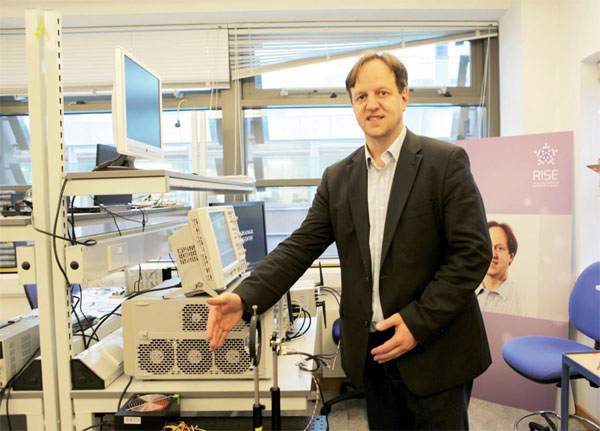Setting the Internet alight
Updated: 2014-12-19 09:10
By Zhang Chunyan(China Daily Europe)
|
|||||||||||
Founder of Li-Fi technology wants to partner with Chinese companies to commercialize invention
Professor Harald Haas, chair of mobile communications at the University of Edinburgh, is on the cusp of making one of the most common methods of connecting to the Internet, via Wi-Fi, a thing of the past.
And he knows exactly whom he wants to partner with to make that a reality.
|
Professor Harald Haas, chair of Mobile Communications at University of Edinburgh, wants to work with Chinese companies. Zhang Chunyan / China Daily |
Since a 2011 TED Global Talk, Haas has been promoting Li-Fi, a technology he invented that uses visible light for high-speed connections to and high-data transmission through the Internet.
Using little more than LED bulbs equipped with computer chips, light is flickered imperceptibly to the human eye for optical data transmission. Li-Fi data is then received by photoreceptors on a computer at speeds much greater than those of Wi-Fi.
With Li-Fi, people can connect to the Internet simply by being within range of an LED beam. They could also conceivably transmit data using the headlights on a car.
Many experts have said Li-Fi represents the future of mobile Internet because of its cost-effectiveness and greater efficiency compared with Wi-Fi.
"Ten years ago, when I saw 4G coming and that the amount of data we will be sending through devices would be increasing exponentially over time, I thought we could use LED light bulbs for data communication, so I then started research on LEDs."
To further his research and begin developing the technology into products, Haas says he wants to work with Chinese companies for two simple reasons: China is open to embracing new ideas and the nation's mobile communications and lighting industries are rapidly developing.
In hoping to engage with China's high-tech companies, Haas recalled his first links with China from 2001 to 2002 when he worked at Siemens and later on a research project with Nanjing University in Jiangsu province. Since then, he has visited China on numerous occasions and witnessed the rapid development of its lighting industry. He also compliments the nation on how quickly its mobile technologies have developed.
"China has always gone its own way with Time Division Synchronous Code Division Multiple Access, a mobile telecommunications network, and the success of Huawei is an exemplification of the tremendous success of the mobile communications development," he says.
"What I like in China is that attitude to embrace new thinking. Often here (in the United Kingdom) when you bring new things to the table, there will be at least hundreds of arguments that will be brought against you as to why it couldn't work, but China is very open for this fluid dynamic discussion of new ideas."
Haas says Li-Fi will primarily alter the lighting and communications industries, which have in the past invested a great deal in radio wave technologies.
"Let's imagine street lamps. How many street lamps do you see on the street across the planet? Each of these street lamps could be a future 5G radio mast. Why would you install millions of new radio masts in the city when you can have street posts and use the light to transmit gigabytes per second."
"And you can have an intelligent transport systems in crowded cities like Beijing, and when you know there's a traffic jam, you route cars in different ways. If you think of hotels, airports, stadiums, where many people are put together in a very confined space, Wi-Fi doesn't work because you only have one Wi-Fi router in a corridor, and everyone has to share, but look at the number of light sources you have in a corridor of a hotel, and every light source could be like a router, so you don't have to share the resources, and many people get there individual router, getting therefore lots more data."
He and his team have invited companies from the West and China to work with them in the Li-Fi R&D Center at the university.
"We've talked a lot with American companies, and also from the rest of Asia, but we have not yet engaged very much with China," Haas says.
Haas' group, along with researchers from Cambridge, Oxford, St. Andrews and Strathclyde universities, are halfway through a four-year, 5.8 million pound ($9.1 million) project funded by the Engineering and Physical Sciences Research Council in the United Kingdom. They are pursuing ultra-parallel visible light communication, which would use multiple colors of light to provide high-bandwidth linkages over distances of a few meters.
The ramifications of this project are huge, especially with the Internet of Things in full swing and a global crunch in bandwidth expected to bite increasingly hard in coming years.
In his aim to commercialize Li-Fi, Haas says, "I would like to engage and talk to people and see how we can jointly make Li-Fi a global success."
One distinct advantage to Li-Fi is that it reportedly offers greater security because data cannot be intercepted without a clear line of sight.
While Haas and his team are still talking to businesses to realize his dream one step at a time, he is "seeing that the glass is not half empty, but half full for the opportunities that will come from bringing in new concepts and new industries."
Carolynn Look contributed to this story.
zhangchunyan@chinadaily.com.cn
( China Daily European Weekly 12/19/2014 page22)
Today's Top News
China set to make tracks for Europe
Global net tightened in hunt for Chinese fugitives
Russians flock to stores to pre-empt price rises
Wong Kar-wai: Timeless director who makes time wait
China pledges $3b investment for Europe
Obama to sign Russia sanctions bill, White House says
Beijing condemns Pakistan school attack
Wolfsburg signs China midfielder for 2 1/2 years
Hot Topics
Lunar probe , China growth forecasts, Emission rules get tougher, China seen through 'colored lens', International board,
Editor's Picks

|

|

|

|

|

|






